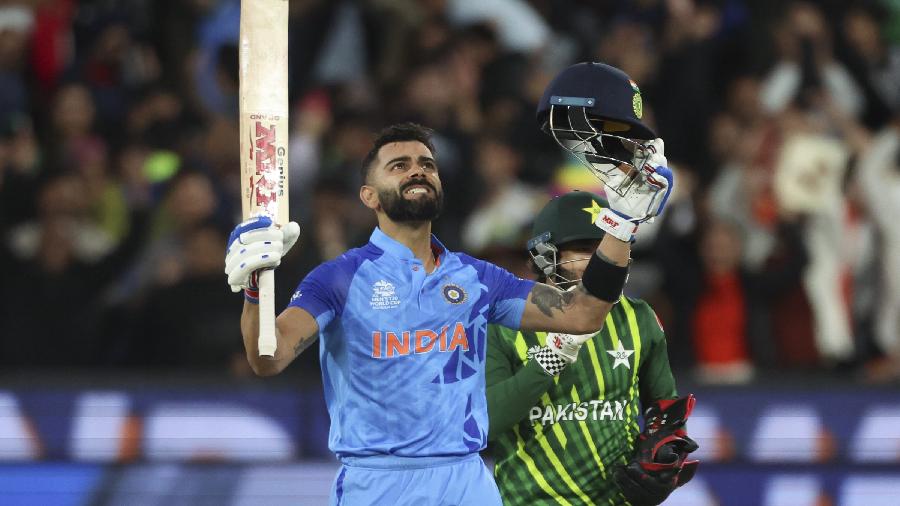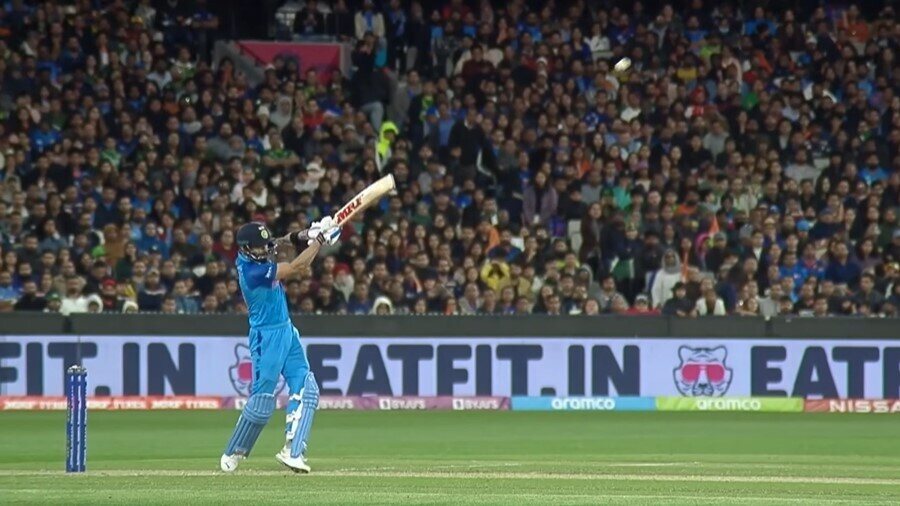If you merely Google “Kohli shot”, you will probably generate 40 per cent more results than the entire population of Australia — within just 24 hours of the India-Pakistan T20 World Cup match.
I present my case. We have seen so many sixes being hit at virtually every level of cricket that the sixer has become commoditised. There is no specialness left in it. Each six is like every other. Such a diverse range of sixes — behind the wicket keeper, scooped or reverse-swept — have been hit that there is nothing left to be ‘discovered’. A straight six off a fast bowler (once considered the most romantic stroke in the game) is now what even 10-year-olds take for granted. A six over cover is almost like a BCom on a batsman’s resume (the base minimum); a hoik over mid-wicket evokes a metaphorical yawn. It is good, it is desirable and it is remunerative but it is no longer a big deal. In this ravenous world, if you cannot produce three sixes in an over, no child is going to lift her eyes from the homework to look at the screen.
And then Kohli produces the ‘Backaway Six’. His straight hit off Haris Rauf in the penultimate over did not just turn the India-Pakistan game; it is being rated as possibly the best shot since the T20 format was launched and possibly the most innovative in the history of Indian cricket.
Niche within a niche
Kohli’s shot is being logged in a niche folder of Indian cricket: Srikkanth’s square drive for four on one knee in the World Cup 1983 final off an Andy Roberts delivery that may have been declared a wide if it had been left alone; Gavaskar hooking Malcolm Marshall off his brow for six in the New Delhi Test in 1983-84 (when he would have normally ducked); Azharuddin ‘putting’ Pat Pocock golfer style with a vertical bat to the left of the wicket keeper on the leg side (described by John Woodcock as “perfection in sport”) in just his second Test appearance; Yashpal Sharma leaving his leg and middle stumps exposed to hit fast bowler Bob Willis for a perpendicular six over square leg in the 1983 World Cup semi-final (closest I have seen an Indian batsman get to Viv Richards’s last ball six off Mike Hendrick in the 1979 World Cup final); Tendulkar slashing Shoaib Akhtar from over the ninth stump for a six over point in the 2003 World Cup semi-final; Yuvraj’s third six over cover — an inside-out shot, which is difficult to execute because you do not get the advantage of your body weight in the bat swing — off Stuart Broad in the India-England T20 World Cup encounter in 2007 (the same over he hit an unprecedented six sixes).
But Kohli’s shot was different. The other shots that have been described were not considered impossible to execute, however challenging they may have been within the game’s context and within the limitations of the human anatomy. Kohli’s shot was considered improbable to have pulled off when it happened; it is being considered near-impossible to execute at any other time either. The shot appears to have been produced at the perimeter of human possibility.
One thing right, four things wrong
This is why: a shot is the result of getting five things right. One, impact at the right point in the arc of the bat’s movement from the beginning of the stroke to the end (the bat hitting the ball early in the arc could produce a completely different outcome than meeting it at the later end of the arc). Two, the point of impact on the bat (the ball hitting the bat on its sweet spot in the middle can generate an outcome different than if it were to hit the bat’s shoulder or toe). Three, the height of impact (hitting at a lower height with a free extended arm generates a superior power-outcome ratio than if the ball were intercepted with a restricted arm nearer the waist or shoulder). Four, the direction of the stroke (easier to accelerate the ball towards the boundary by using the pace of the bowler than by hitting against the pace). Five, the muscle going into the shot (which makes the difference between getting caught at mid-off or clearing long-off).
Now, see how Kohli fared against the five. He middled the ball, which was just about the only conventional box he ticked of the mandatory five. This is what he did not achieve: he caught the ball on the up and rising and not at the low end of the arc, which means it was intercepted pre-maturity. He hit the ball a little above the waist, neutralizing any advantage he may have derived from his body weight. He hit against the ball’s velocity, which is more difficult than using the bowler’s pace and hitting behind the wicket. He cleared a longer distance by hitting over long off, an effective 20 yards more than if he had swung it over mid-wicket (assuming a completely circular ground).

TT Archives
I had heard of Clyde Walcott (of the Three W’s fame) hitting a six off the backfoot and dismissed it as apocryphal. It couldn’t possibly be done, I told myself. But on Sunday evening, I saw it being done; Kohli never moved into the shot, but moved away; he made room, so to speak, finishing a few steps behind where batters normally finish when they hit straight, moving well outside the crease with the stride, using their body weight as they lean into the ball. Kohli did not move into the ball; he withdrew. He countered the multiple downsides related to the shot (the boxes he could not tick) by generating such a disproportionate impact using the two assets at his disposal — timing and strength — that he stood in almost the same place and delivered one of the most outrageous shots in the game.
Kohli’s was more than a cricket shot; it was a metaphor for life. One may be confronted with diverse challenges with reduced resources, but a winner in the mind will use a complement of character, courage and competence to make all the difference.
